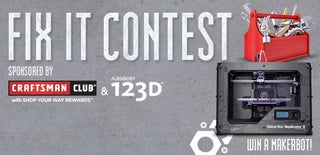Introduction: Vacuum Roller Brush Repair - Overkill Edition
My less than a year old vacuum cleaner started working poorly, so I checked the normal things (belt was tight, no clogs in any of the tubes, etc.) Turning it back on and trying it again, there was the sudden smell of burning wood. Since the roller brush was the only wooden piece that I was aware of, out it came. To my surprise the drive portion of the roller had failed.
The picture makes this clearer, but basically the drive pulley (where the belt goes) has a splined metal shaft that is press fit into the wooden roller. Apparently there was resistance enough on the roller brush for the splined shaft to shear off the mated wood surface and start spinning like mad, and the friction was starting to burn the wood. This type of failure is usually caused by string, fibers, etc. getting wrapped around the roller and adding a lot of drag. Since we regularly clean off the roller and there wasn't anything on the roller when it failed, I took a closer look. It really seems like there is a design flaw on this particular vacuum, as the splines are actually quite short and closely spaced so they don't make a very solid contact with the wooden roller.
I brought the roller brush to the local dealer (since the roller brush was advertised as having a one year warranty), and they said the warranty doesn't cover that type of failure. I asked what kind of failure is covered, and they couldn't name any. However, they were very willing to sell me a replacement for almost $60.
I declined and headed to my local TechShop to use way more tools than really necessary to re-join the two pieces. Thus the Overkill Edition comment.
I repaired this at TechShop www.techshop.ws
The picture makes this clearer, but basically the drive pulley (where the belt goes) has a splined metal shaft that is press fit into the wooden roller. Apparently there was resistance enough on the roller brush for the splined shaft to shear off the mated wood surface and start spinning like mad, and the friction was starting to burn the wood. This type of failure is usually caused by string, fibers, etc. getting wrapped around the roller and adding a lot of drag. Since we regularly clean off the roller and there wasn't anything on the roller when it failed, I took a closer look. It really seems like there is a design flaw on this particular vacuum, as the splines are actually quite short and closely spaced so they don't make a very solid contact with the wooden roller.
I brought the roller brush to the local dealer (since the roller brush was advertised as having a one year warranty), and they said the warranty doesn't cover that type of failure. I asked what kind of failure is covered, and they couldn't name any. However, they were very willing to sell me a replacement for almost $60.
I declined and headed to my local TechShop to use way more tools than really necessary to re-join the two pieces. Thus the Overkill Edition comment.
I repaired this at TechShop www.techshop.ws
Step 1: Materials and Equipment
Materials
Small nail
Epoxy
Equipment
Drill press
Drill bit (size of nail)
Vise
Sandblaster
Needle file
Tin snips
Hammer
Marker
See? Overkill...
Small nail
Epoxy
Equipment
Drill press
Drill bit (size of nail)
Vise
Sandblaster
Needle file
Tin snips
Hammer
Marker
See? Overkill...
Step 2: Drill Holes
The end goal is to mechanically pin the two pieces together with the nail and epoxy. Start by drilling a hole through the roller brush and splined shaft. It is important to drill the hole as close as possible through the center of the two pieces. To make this easier, first clamp the roller brush in a vice using two pieces of scrap wood. The scrap wood protects the bristles from getting crushed by the vice. Now drill a hole through just the roller brush with the drill press (this makes it easier to see and drill the hole through the center). Next assemble the two pieces together and make an alignment mark on both pieces. This will help during final assembly. Using the existing hole in the roller brush as a guide, drill through the splined shaft.
Step 3: Sandblast the Shaft
The valleys on the splined shaft were somewhat clogged with bits of wood and perhaps a little corrosion. Although the nail will provide the vast majority of the strength, I wanted a clean surface for the epoxy to bond to. A few minutes with the sandblaster stripped the splined shaft down to clean bare metal.
Step 4: Trim the Nail
Cut the nail with the tin snips so that it is just shorter than the diameter of the roller brush.
Step 5: Score the Roller Brush
The hole in the roller brush was burnished smooth by the spinning splined shaft. Take a needle file with a sharp edge (like a flat or triangular file) and file several grooves around the inside of the hole. These will help the epoxy anchor into the roller brush.
Step 6: Epoxy and Pin the Assembly
Mix the epoxy and liberally apply to the splined shaft. Insert the shaft into the roller brush being careful to align the two marks made in an earlier step. Then apply epoxy to the nail hole, and drive the nail in with a hammer. Wipe off any excess (being careful not to get any on your skin). Give the epoxy ample time to set.
Step 7: Back to Vacuuming...
Now it is time to reassemble the vacuum cleaner, clean up, and move onto the next instructable...

Participated in the
Fix It Contest

Participated in the
3D Printing Contest











